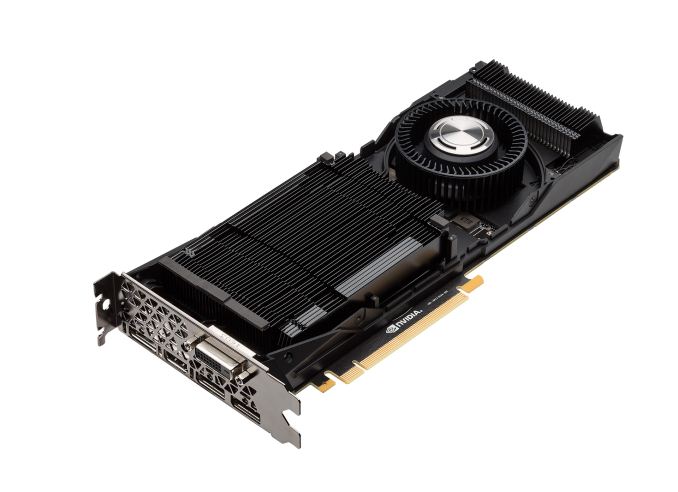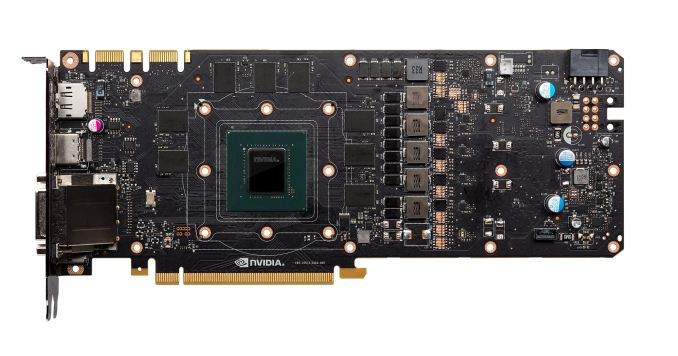The NVIDIA GeForce GTX 1070 Ti Founders Edition Review: GP104 Comes in Threes
by Nate Oh on November 2, 2017 9:00 AM EST- Posted in
- GPUs
- GeForce
- NVIDIA
- Pascal
- GTX 1070 Ti
Meet the GeForce GTX 1070 Ti Founders Edition
For the GeForce GTX 1070 Ti Founders Edition, pinned at the official MSRP of $449, NVIDIA has essentially plopped the GTX 1070 Ti GPU into a GTX 1080 board. This makes a lot of sense considering that this late-cycle card has the same GPU and 180W TDP requirements of NVIDIA's GeForce GTX 1080. Doing so allows NVIDIA to drop in the new specification and go with minimal changes, and similarly, their partners can take their own GTX 1080 designs and quickly reconfigure them for the GTX 1070 Ti.
The end result of this decision is that the GTX 1070 Founders Edition has the same power delivery and cooling specificaitons as the GTX 1080. Which is to say that it retains the same vapor chamber + blower cooling design, and the same 5+1 dual-FET power design. Similarly, that means the GTX 1070 Ti also has the same 120% power limit, and so extending the TDP to 216W. Otherwise, the PCB is exactly the same as the GTX 1080.
It is notable that the GTX 1070 Ti Founders Edition gets the vapor chamber cooler, as the card does not carry a price premium like the other Founders Edition cards do; NVIDIA is not charging more than their partners here. As a high efficiency cooling solution, the vapor chamber works well with the GTX 1070 Ti's increased (relative to the GTX 1070's) 180W TDP and 120% power limit. And while the blower fan is not the quietest, the Founders Edition is able to boost well past its paper-specified clockspeeds.
As we weren't provided with the GTX 1070 Ti PCB photos, we are using the GTX 1080 PCB with GDDR5X modules as an example. As with previous NVIDIA reference PCBs, the 5 GPU power phase and 1 GDDR5 phase is fine for stock operation and mild overclocking, rather than catering to the needs of hardcore overclockers. While not a major point, the Founders Edition isn't really apt to be pushed as a real "overclocking" card; it will boost a little higher but the user experience won't be significantly affected.
Finally, given the identical-to-1080 board design, the rest of the specifications should not come as a surprise. The 10.5" card requires a single PCIe 8-pin power connector for additional power, which combined with the 75W of the PCIe slot, gives the complete card more than enough power for its 180W TDP. Meanwhile on the display side of matters, the GTX 1070 Ti has 3x DisplayPort 1.4, an HDMI 2.0b port, and 1 DL-DVI-D port. The GTX 1070 Ti does support SLI, like all Pascal cards from the GTX 1070 and up.












78 Comments
View All Comments
Bp_968 - Tuesday, December 26, 2017 - link
I know this is an old article but I had to comment on the desktop space being "stagnant". That's mostly true for general consumers and corporate buyers but absolutely not true for med/higher end systems targeted at gamers (and miners). Those two markets are pushing massive demand for high performance desktop CPUs and GPUs (which you can see in AMD and NV's pricing and availability on their GPUs). The year over year performance improvement in CPUs is pretty boring right now but GPUs are still pretty exciting and still seem to have some big leaps left in them. I'm interested in seeing if Intel is going to be able to bring out a capable 3rd option in the discrete GPU space in the next few years. Their track record isn't good so far but having a 3rd player in the GPU/Compute space could really shake things up.I'm with you on the Ryzen APUs. If AMD can manage to make an APU with 1050/1060 level performance that fits in a thin and light notebook that could be a real game changer for many of us. I've mostly given up on gaming laptops because they end up being more of a portable then a mobile system and for most things I do on a laptop I'd just prefer the really thin and light setup. If I can manage to get both thin and light *and* decent gaming performance (even if you need to be plugged in to maintain battery life when gaming) then that would be killer.
The only problem I see is the push for 4k monitors on these little laptops. No APU is going to be able to push 4k anytime soon, but I've never tried gaming at 1080p on a 4k panel and since its still a square pixel at 1080p, it might look fine, in which case it would be a non-issue.
Hxx - Thursday, November 2, 2017 - link
That just makes no sense and heres why. First off, If you're paying over MSRP then you are not paying Intel or Amd or Nvidia or whatever. You are paying that distributor or the retailer or whoever gets those cards from the manufacturer. Second, if the manufacturer quotes an MSRP then this price already covers the costs and whatever the manufacturer wants to charge you for.It has nothing to do with whether or not you can afford it. Thats irrelevant. And if you're wondering WHY the vendor charges over MSRP is because 1) they can, 2) they know the demand is high so they know there are suckers like you who are willing to pay.
"Bullwinkle J Moose" - Thursday, November 2, 2017 - link
Higher prices would destroy AMDTo demand a higher price, they would need to compete with NVidia with cards that ran cooler/quieter, used less power and outperformed NVidia cards for the same price
That's just not happening anytime soon
Hixbot - Thursday, November 2, 2017 - link
The MSRP seems a bit high. The MSRP is a bit irrelevant as miners will push up the price even further.For me, it's a still a good purchase because of the blower cooler which I need for my SFF PC, all other Founder Edition cards are unavailable.
Wwhat - Sunday, November 12, 2017 - link
I think any device relying on Nvidia or AMD drivers/software should reflect that, and they should not dare to sell anything over $500.Samus - Thursday, November 2, 2017 - link
I’m glad I’m not the only one who finds it ridiculous that the mainstream cards are now $100-$150 more than they used to be...These price brackets have just gotten ridiculous. I’d like to go back 15-20 years to when the most expensive cards were $200 (TNT2 Ultra :)
Hxx - Thursday, November 2, 2017 - link
It wasnt like this a year ago. This year we just have a couple phenomenons overlapping and the result is this...a market where the demand is high and supply is low. Maybe next year things will change but this year is not consistent with the past couple years where a videocard would drop significantly in price 6 months after release.BrokenCrayons - Thursday, November 2, 2017 - link
I remember splurging on an original TNT with 16MB of VRAM. It was a Diamond Viper V550, I think...but paying $130 or so for it back then felt like an awful lot. It was passively cooled by a tiny little heatsink, but was among the highest performing video cards at the time. Heh, I did want to shove a pair of Voodoo2s in the system behind it for Glide titles. Anyhow, I think economic inflation can account for some of the cost increase in higher end video cards, but certainly not all of it.webdoctors - Thursday, November 2, 2017 - link
The TNT2 was awesome and the best bang per buck at the time. However, the average price of gas (including state taxes) was $1.14 in 1999.https://www.statista.com/statistics/204740/retail-...
Now its $2.14. The Feds have been printing money so fast its essentially become water and diluted. That's why gas and video cards are going up (its true inflation, not the one fed by propaganda outlets). Unless you switch to using the gold standard where it was $290 in 1999 and now its ~$1500.
https://goldprice.org/gold-price-usa.html
So really if you wanted to buy the TNT2 today, instead of $200 it would be $400+, in short get the gtx1060 6gb and be happy.
RiZad - Monday, November 6, 2017 - link
counting for inflation they are ~1% more expensive. based on the tnt2 ultra that launched at $299 not $199